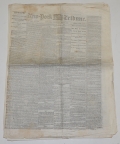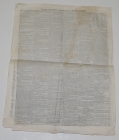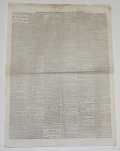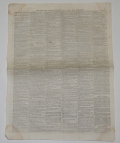site search
online catalog
THE NEW YORK HERALD, MAY 18, 1865 – TRIAL OF THE LINCOLN ASSASSINATION CONSPIRATORS
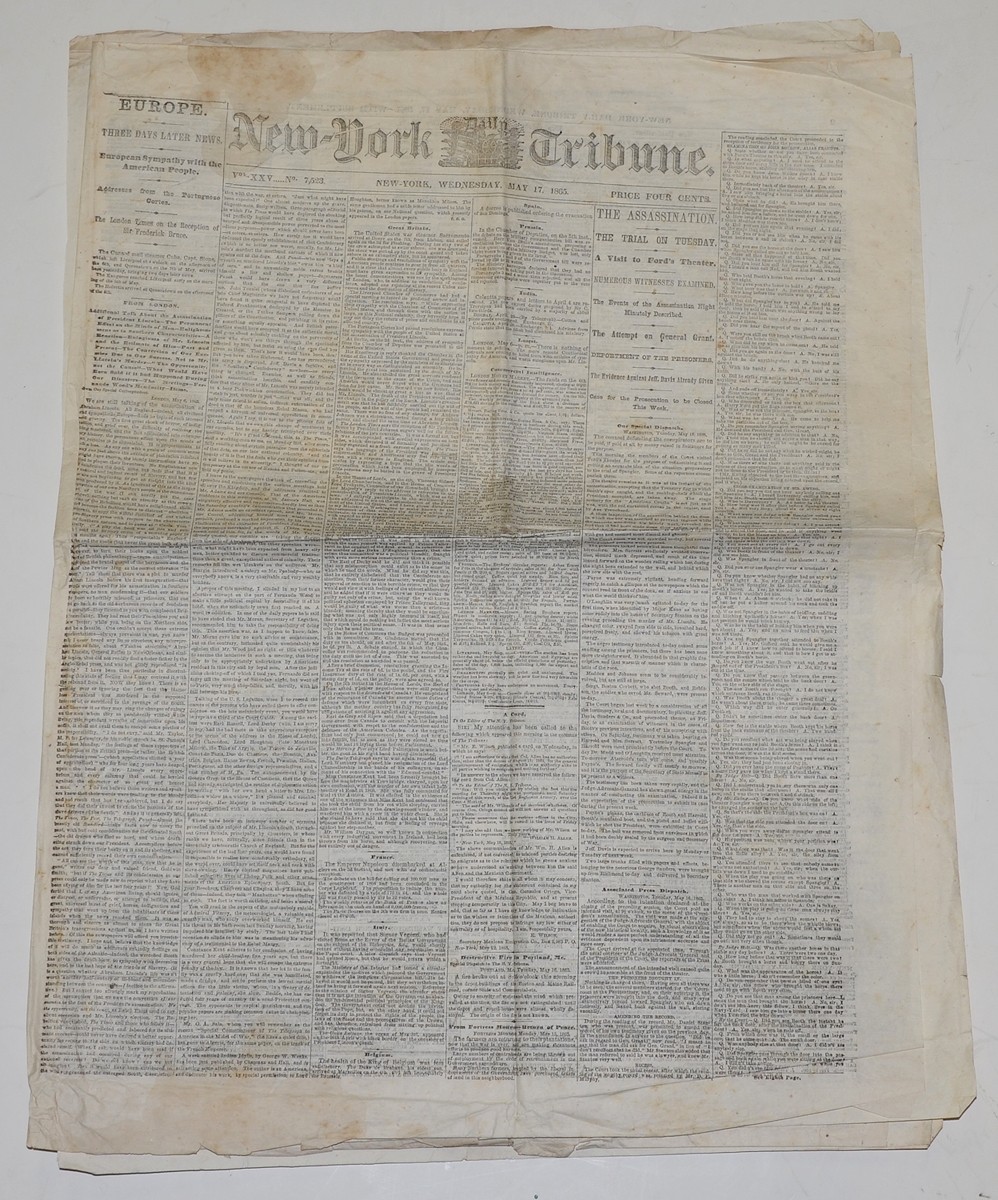
$175.00 SOLD
Originally $225.00
Quantity Available: None
Item Code: 173-4252
Vol. XXV….No. 7,523. Very good condition; some scattered light staining. Fold lines; creasing and minor chipping to edges of pages. Supplement pages 9 and 10 printed as loose pages.
Front Page –
-The Assassination. The Trial on Tuesday. A visit to Ford’s Theatre. The events of the assassination night minutely described. The attempt on General Grant. Deportment of the prisoners. The evidence against Jeff Davis already given.
-The court visits Fords Theatre and inspects the wooden bar put on the door of the presidential box by Booth.
Prisoner observations:
-Mrs Surratt studiously avoided observation, seemed much depressed, and much of the time leaned forward on the wooden railing. ….
-Payne was extremely vigilant, bending forward eagerly ….
-O’laughlin was very much agitated today for the first time…..(O’Laughlin was supposed to kill Grant at Secretary Stanton’s house). He changed color, swayed from side to side, breathed hard, perspired freely and chewed his tobacco with great energy.
-Payne’s pick ax, the carbines (Spencers) of Booth and Harold, Booth’s mutilated boot, and the pistol and bullet with which he shot the President were exhibited in court today. The ball (from Lincoln’s brain) was removed from envelopes which had been doubly sealed by the surgeon and the Secretary of War.
-Testimony of John Borrow –alias Peanuts. (The stagehand boy who held Booth’s horse during the assassination) He states Spangler gave him Booth’s horse to hold. Booth knocked him down with the butt of his knife as he mounted his horse to escape.
Page 8 – The Assassination
-testimony of Mary Ann Turner – who saw Spangler and Booth together with his horse in the alley behind Ford’s theatre.
-testimony of Mary Jane Anderson – who saw Booth ride off from the alley so quickly she thought his horse ‘had run off with the man’. She also implicates Spangler.
-testimony of William Browning – private secretary to Vice President Johnson. He describes getting the card from Booth addressed to the Vice President, at his residence at the Kirkwood House, the day of the assassination. “Don’t wish to disturb you, are you at home? John Wilkes Booth”
-testimony of Major Kilbourne Knox – the night before the assassination O’Laughlin walked passed him and Secretary Stanton into Stanton’s house, where General Grant was sitting in the parlor. He appeared to be drunk and was escorted out of the house. O’Laughlin was supposed to have murdered Grant in the plot.
-Testimony of Dr. Robert King Stone – Lincoln’s personal physician. He states he was sent for by Mrs. Lincoln immediately after the assassination. He finds the president at the Peterson House and the army physicians present who had been at Ford’s theatre turned over Lincoln’s care to him.
“I instantly found that the president had received a gun-shot wound in the back part and left side of the head. Into which I carried readily my finger, and at once informed those around that the case was hopeless; that the president would die. That there was no positive limit to his life; that his vital tenacity was very strong; that he would resist as long as anyone, but death would certainly follow. I remained with him as long as long as it was any use to do anything, but of course nothing could be done. He died the next morning about half past seven.”
The next day he conducts a post mortem examination of the president and extracts the bullet from the brain:
“the next day when the body was ready to be embalmed….I traced the wound through the brain; the ball was found on the interior part on the left side of the brain; it was a large ball, resembling those shot from the pistol known as the Derringer; an unusually large ball, that is a larger ball than that is ordinarily used in pocket revolvers.
He describes it as a leaden ball: “ a handmade ball from which the tag had been cut from the end. The ball was flattened or compressed somewhat in the passage through the skull, and a little portion had been cut up in its passage through the bone. I marked the ball with the initials of the President.”
-testimony of Sgt Silas Cobb – who passed JWB and then Harold over the Navy Yard Bridge during the escape. He did not sense anything out of the ordinary and of course did not know the president had just been assassinated.
-testimony of Will T Kent – he describes finding Booth’s Derringer on the floor of the Presidential Box at Ford’s theater. The surgeon’s in the box used his knife to cut open Lincoln’s clothes to treat him.
-testimony of Lt. Alexander Lovett – He describes going to Dr. Mudd’s house to question him. Mudd admits two strangers visited and Mudd set ones’ broken leg. Lovett then returns to Mudd’s house a few days later and arrests him. Mudd’s wife brings down John Wilkes Booth’s boot with his name in it.
Page 10 – May 17th Supplement. (items too late to be published in earlier editions)
“The Assassination – Trial of the Conspirators
-testimony of Mr. Reed, who saw John Surratt at the National Hotel in late 1864.
-testimony of Peter Flattervriel – who served JWB a shot of whiskey in the restaurant next to Ford’s Theatre, just before Booth went in for the assassination. He also testifies that Harold came to the restaurant looking for Booth that day.
-testimony of Sgt. Joseph Dye – who saw Booth enter the theatre after conferring with two other men on the street.
-Testimony of John Buckingham – the doorkeeper at Ford’s Theatre, who saw Booth enter the dress circle leading to the President’s box. He then saw Booth leap onto the stage with a knife in his hand.
Testimony of Joseph Ferguson – innkeeper – he was attending Ford’s Theatre and sees Booth pass the Dress Circle and go into the President’s Box. As Booth jumped from the box he testified–“I could see the knife glancing in his hand, at that time the president was leaning forward on his hand towards the right looking down on some person in the orchestra; he was not looking at the stage. He was looking between the post and the flag decorating the box. As he jumped over I saw it was Booth; I saw the flash of a pistol right in the box, and heard him exclaim –‘sic semper tyrannus’.
“I saw the president raise his head, and saw Mrs. Lincoln catch him by the arm”…
“Booths spur was caught by the flag; it was the blue part of the American Flag; as he went over his spur caught on the molding on the edge of the box and also the flag. The spur was on his right heel”.
-Testimony of Capt. Theodore McGovern – he was sitting in the dress circle next to Lincoln’s Box. He saw JWB approach and take out a calling card and handed it to the president’s messenger. He sees JWB leisurely taking stock of the entire theatre. He sees Booth pass into the president’s box, and then sees him descend to the stage with a knife in his hand.
Testimony of Rufus - Stabler – who frequently saw Booth, Atzerott, Surrat together at his stables. Booth paying the bills for all of their horses.
Testimony of James Pumphrey – who rented Booth the horse he rode the day of the assassination.
Testimony of Major Henry B. Rathbun – who was in the actual box with Lincoln during the assassination and wounded by JWB’s knife. He states that Booth was standing four or five feet from the president when he fired. And that he himself received the wound from Booth’s knife when “ it was held flat and horizontal; the entry of the wound would indicate it; it came with a sweeping blow from above”.
-Testimony of John Withers – a member of the orchestra at Ford’s Theatre. “I was astonished that a shot had been fired while playing ‘Our American Cousin”. ..Just then I met a man running before me; I stood completely paralyzed:…he hit me on the leg, turned me around and made two cuts at me, one at the neck and one on the side; as he went past me I said “that is Wilkes Booth”, with that he made a rush for the door, and out he went; just then I heard the cry that the president was killed, and I saw him in the box, apparently dead.”
Testimony of John Mills, stagehand of Ford’s Theatre, who implicates Spangler getting Booth’s horse held in the alley during the assassination.
-Testimony of John Selecman – of Ford’s theater who also implicates Spangler in getting Booth’s horse ready in the alley.
The Secret Testimony – this is the much-debated by-historians condensed record of the testimony acquired in secret by the Assassination Commission, without reporters present. To this date it is not known whether there is any accuracy to these statements. But some of the statements have become legendary in the Lincoln assassination historiography.
-alleged that Confederate General Edward Johnson held a meeting in the Shenandoah Valley with his officers that Booth attended. And Booth said that ‘old Abe Lincoln must go up the spout”. This phrase somehow stuck in the minds of people then and now, whether actually said or not.
-alleged that the Confederate 2nd Virginia Regiment held a meeting which Booth attended. And in this meeting it was discussed the sabotage of Northern Cities (like the St. Albans VT raid, and the fires set in NY, which did actually happen.). And the possibility of the assassination of the president and the cabinet. This allegation was strengthened in the 20th century by a discovered photograph of what may be Booth in the uniform of the 2nd Virginia taken in the very first month of the war, with other 2nd VA soldiers and officers.
-the most damning allegation of all was that of a unnamed women who overheard a conversation on a NYC trolley-car between what the court assumed was Booth and another conspirator. Supposedly she picked up two letters that were dropped on the car. One of the letters became an essential part of the Lincoln assassination historiography, whether substantiated or not.
“Dear louis – the lot has fallen on you to become the Charlotte Corday of the Nineteenth Century. Abe Lincoln must die now; you can chose your weapons, the cup, the knife, the bullet, etc. “
Much was made of this supposed note in the history of the assassination. Charlotte Corday assassinated Maurat in the French Revolution. As far as is known, the original of this note, if it ever existed, is lost, and the identity of the women who presented this evidence, if it was real, is unknown. But this statement appears in almost every history of the assassination written in the past 150 years.
Page 9 – Supplement – May 18, 1865, printed before the regular morning edition of that date.
The Assassination – Trial of the Conspirators – Conclusion of Yesterday’s Testimony.
-Cross examination of Lt. Lovett – who again describes questioning Dr. Mudd before Booth was found, and the Mudd’s evasive answers.
-Additional testimony of Lloyd who describes the two interviews of Dr. Mudd and how he changed his answers about Booth.
-Testimony of Col. Willes – who also interviewed Dr. Mudd a dozen times after his arrest, and Mudd admitted he had met Booth previously before the night he treated his leg.
Unpublished Testimony –these were testimonies that were taken in secret, without reporters present, during the first week of the trial.
-Henry Van Steinacker – a confederate officer who claims he met Booth after the battle of Gettysburg, and a man he thought was Booth stated the other unsubstantiated line that became part of the assassination history – “old Abe will go up the spout”. He also claimed that Booth attended a secret meeting of the 2nd Virginia Infantry, which he did not attend himself. He also claimed he heard from someone else the meeting was about laying waste to northern cities and killing Lincoln and his cabinet. He claims there was a secret society for this purpose – The Golden Circle. Interestingly, Van Steinacker was never cross examined and history has no supporting evidence for his conjectures.
Mrs. Mary Hudspeth – another damaging testimony, testified in secret, that has never been corroborated, yet has endured through the Lincoln assassination mythology. Hudspeth claims she was riding the Third Avenue trolley car in New York City in November 1864 and saw two ‘suspicious’ men talking in front of her. And after they left she saw an envelope on the floor, which she assumed had come from the ‘suspicious men”. This is the famous ‘you are to be the Charlotte Corday of the Nineteenth Century’ letter. “Abe must die, and now! You can choose your weapon – the cup, the knife, the bullet…..strike for your home, your country, but strike for sure” Hudspeth was not sure, but she thought the man who dropped the letters was Booth (who was probably in Montreal at that time). Again, she was never cross examined but these letters endure on in assassination historiography.
-GW Bunker – another testimony in secret. He worked at the National Hotel in Washington DC where Booth kept a room from November 1864 till the assassination. No cross examination.
-William Wheeler – another testimony recorded in secret. He claims he saw Booth in Montreal walking across the lobby of the hotel, St. Lawrence Hall. No cross examination.
-John Deveney - who talked to Booth at the hotel in Montreal. He thinks the men he saw talking to Booth in the lobby were the Confederate secret service officers, Clay, Thompson, And Sanders. He then sees Booth the day of the assassination in DC, and is also present at Ford’s Theatre during the assassination. He hears Booth yell –‘Sic Semper Tyrannus”.
-Lt. General Ulysses S. Grant – who testifies that Washington DC, and the surrounding areas of Virginia and Maryland, are under Martial Law.
-Joseph Simmonds – who testifies about Booth’s investment in oil properties in PA.
-Samuel Jones – a blind man who testifies he heard Rebel officers offering money for someone to kill Lincoln.
-Samuel Knapp Chester – a friend and fellow actor with Booth, who testifies Booth told him in NYC that he was part of a plot to kidnap the president. He stated Booth thought they could capture the president during a play at Ford’s Theatre and whisk him to Richmond. Booth indeed attempted the kidnapping of the president in January 1865 but the plot unraveled when Lincoln changed his plans. Chester refused to join the plot.
Chester’s testimony is regarded as reliable, and it is he who gives us Booth’s famous quote – “what an excellent chance I had to kill the president, if I had wished, on Inauguration Day. ” Indeed, in the famous Mathew Brady photograph of Lincoln’s second inauguration on the Capitol Steps, Booth is indeed staring down at Lincoln from a pillar just over the speaker’s rostrum. [km/ld]
~~~~~~~~~~~~~~~~~~~~~~~~~~~~~~~~~~~
THIS ITEM, AS WITH ALL OTHER ITEMS AVAILABLE ON OUR WEB SITE,
MAY BE PURCHASED THROUGH OUR LAYAWAY PROGRAM.
FOR OUR POLICIES AND TERMS,
CLICK ON ‘CONTACT US’ AT THE TOP OF ANY PAGE ON THE SITE,
THEN ON ‘LAYAWAY POLICY’.
Inquire About THE NEW YORK HERALD, MAY 18, 1865 – TRIAL OF THE LINCOLN ASSASSINATION CONSPIRATORS
For inquiries, please email us at [email protected]
Most Popular
Historical Firearms Stolen From The National Civil War Museum In Harrisburg, Pa »
Theft From Gravesite Of Gen. John Reynolds »
Cavalry Carbine Sling Swivel »
Fine Condition Brass Infantry Bugle Insignia »
featured item
VIVID EYEWITNESS ACCOUNT OF THE BATTLE OF GETTYSBURG – LT. HENRY J. WALTZ, 93RD PENNSYLVANIA VOLUNTEERS
An eyewitness account of the Battle of Gettysburg written by Lt. Henry J. Waltz, Quartermaster, Co. I, 93rd Pennsylvania Volunteers. The ledger measures 12” x 7 ½”; covers are rough, some separation to interior binding near the front of the… (1194-04). Learn More »



